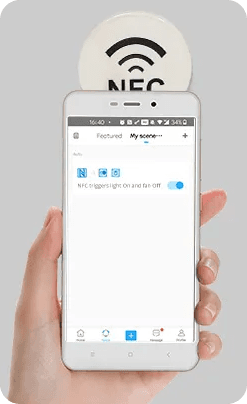Tap to Connect technology has revolutionised the way we interact with our devices, making it easier than ever to connect and communicate with other devices seamlessly. This technology combines the power of Near Field Communication (NFC) and Bluetooth pairing to provide a simple and efficient way to establish connections. In this article, we will delve into the world of Tap to Connect, demystifying its underlying technologies, exploring its benefits and use cases, discussing its challenges and limitations, and looking at future trends and developments.
Understanding NFC (Near Field Communication)
Near Field Communication, or NFC, is a wireless communication technology that enables short-range communication between devices. It operates by creating a low-power radio frequency field that allows devices to exchange data when they are in close proximity, typically within a few centimetres. NFC technology is commonly used for contactless payments, ticketing, access control, and data sharing between devices.
One of the key features of NFC is that it doesn't require any external power source, making it highly convenient for users. By simply tapping or bringing two NFC-enabled devices close together, they can establish a connection and exchange information. This makes NFC an ideal technology for quick and easy interactions, such as pairing a smartphone with a wireless speaker or sharing contact information between two smartphones.
Exploring Bluetooth pairing
Bluetooth pairing is a wireless technology that allows devices to establish a secure connection and communicate with each other. It uses radio waves to transmit data over short distances, typically up to 100 meters. Bluetooth technology is widely used for wireless audio streaming, wireless file transfer, and connecting peripherals such as keyboards, mice, and headphones to computers and smartphones.
The process of Bluetooth pairing involves two devices discovering each other, authenticating their identities, and establishing a connection. Traditionally, this process required users to manually search for devices, enter passcodes, and go through a series of steps to establish a connection. However, with the advent of Tap to Connect technology, this process has been simplified to a single tap or touch, making it much more user-friendly and intuitive.
Benefits of Tap to Connect technology
Tap to Connect technology offers numerous benefits for both businesses and consumers. For businesses, it provides a seamless and frictionless way to connect and interact with customers. By implementing Tap to Connect in their products or services, businesses can enhance the user experience, streamline processes, and improve customer engagement. For example, a retail store can use Tap to Connect technology to enable customers to quickly and easily make purchases by simply tapping their smartphones on a payment terminal.
For consumers, Tap to Connect technology offers convenience and ease of use. It eliminates the need for complex setup processes and reduces the time and effort required to connect devices. With a simple tap or touch, users can instantly pair their devices, share information, and interact with each other. This makes Tap to Connect technology particularly useful in scenarios where speed and simplicity are crucial, such as in retail, healthcare, transportation, and hospitality industries.
Use cases for Tap to Connect in various industries
Tap to Connect technology has a wide range of applications across various industries. In the healthcare sector, it can be used to securely transfer patient information between medical devices, ensuring seamless collaboration between healthcare professionals. In the transportation industry, Tap to Connect can enable contactless ticketing and payment systems, simplifying the commuting experience for passengers. In the hospitality industry, it can be used to provide personalised and interactive experiences for guests, such as keyless entry to hotel rooms or quick access to in-room services.
The retail industry can also benefit greatly from Tap to Connect technology. Retailers can use it to enhance the customer experience by allowing shoppers to easily access product information, reviews, and promotions by simply tapping their smartphones on NFC-enabled tags. This not only saves time for customers but also provides valuable data to retailers, allowing them to gain insights into customer behaviour and preferences.
Implementing Tap to Connect in your business
Implementing Tap to Connect technology in your business requires careful planning and consideration. First, you need to assess your specific business needs and determine how Tap to Connect can enhance your operations or improve the customer experience. Next, you need to select the appropriate hardware and software solutions that support Tap to Connect technology. This may involve integrating NFC and Bluetooth capabilities into your existing products or developing new solutions from scratch.
Once you have the necessary infrastructure in place, you need to educate and train your employees on how to use Tap to Connect technology effectively. This may involve conducting workshops or providing online resources to ensure that everyone understands the benefits and functionalities of Tap to Connect. Finally, you need to continuously monitor and evaluate the performance of Tap to Connect in your business, making necessary adjustments and improvements along the way.
Challenges and limitations of Tap to Connect technology
While Tap to Connect technology offers numerous benefits, it also comes with its own set of challenges and limitations. One of the main challenges is interoperability between different devices and platforms. Not all devices or operating systems may support Tap to Connect technology, which can limit its usability and adoption. Additionally, the security of Tap to Connect transactions is a concern, as unauthorised access or data breaches can pose a risk to both businesses and consumers.
Another limitation of Tap to Connect technology is its range and speed. NFC has a limited range of a few centimetres, which means that devices need to be in close proximity to establish a connection. Bluetooth, on the other hand, has a longer range but may experience interference or slower transfer speeds in crowded environments. These limitations can impact the usability and effectiveness of Tap to Connect technology in certain scenarios.
Future trends and developments in Tap to Connect
As technology continues to evolve, we can expect to see further advancements in Tap to Connect technology. One of the key trends is the integration of Tap to Connect with other emerging technologies, such as Internet of Things (IoT) and artificial intelligence (AI). This will enable seamless connectivity and communication between a wide range of devices, creating a truly connected ecosystem.
Another trend is the development of more secure and robust authentication methods for Tap to Connect transactions. This may involve the use of biometrics, such as fingerprint or facial recognition, to ensure that only authorised users can access and interact with devices. Additionally, advancements in wireless charging technology may eliminate the need for physical connections altogether, further enhancing the convenience and user experience of Tap to Connect.
Comparison of Tap to Connect with other wireless technologies
Tap to Connect technology is not the only wireless technology available in the market. Other popular wireless technologies include Wi-Fi, Zigbee, and RFID. Each of these technologies has its own strengths and weaknesses, and the choice of technology depends on the specific requirements of the application.
Wi-Fi offers a longer range and higher transfer speeds compared to NFC and Bluetooth. It is commonly used for wireless internet connectivity and data transfer between devices. Zigbee is a low-power wireless technology that is often used in smart home automation systems. It offers a longer range than Bluetooth and is designed for low-data-rate applications. RFID, or radio-frequency identification, is used for tracking and identifying objects using radio waves. It is commonly used in supply chain management and asset tracking.
When comparing Tap to Connect with these wireless technologies, it is important to consider factors such as range, speed, power consumption, and compatibility with existing infrastructure. Tap to Connect technology offers the advantage of simplicity and convenience, making it ideal for quick interactions and seamless connectivity.
Conclusion and key takeaways
Tap to Connect technology, powered by NFC and Bluetooth pairing, has unlocked new possibilities for seamless connectivity and communication between devices. Its benefits extend beyond convenience and simplicity, offering businesses an opportunity to enhance the customer experience, streamline processes, and improve efficiency. However, challenges such as interoperability and security need to be addressed for widespread adoption.
As technology continues to advance, we can expect to see further developments in Tap to Connect, integrating it with other emerging technologies and improving authentication methods. The future of Tap to Connect holds great promise, providing a foundation for a truly connected world.
In conclusion, Tap to Connect technology is a game-changer in the world of wireless communication. Its potential to simplify and enhance our daily interactions is immense. By understanding and embracing Tap to Connect, businesses and consumers can unlock a world of possibilities. So, why wait? Take the first step towards a connected future with Tap to Connect technology.
Read more about Tap to Connect - https://www.wingcard.io/blog/wing-tap-to-connect



